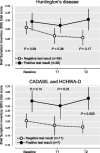Do Attachment Style and Emotion Regulation Strategies Indicate Distress in Predictive Testing?
- PMID: 25641254
- PMCID: PMC4564439
- DOI: 10.1007/s10897-015-9822-z
Do Attachment Style and Emotion Regulation Strategies Indicate Distress in Predictive Testing?
Abstract
Predictive genetic testing for a neurogenetic disorder evokes strong emotions, and may lead to distress. The aim of this study is to investigate whether attachment style and emotion regulation strategies are associated with distress in persons who present for predictive testing for a neurogenetic disorder, and whether these psychological traits predict distress after receiving test results. Self-report scales were used to assess attachment insecurity (anxiety and avoidance) and maladaptive emotion regulation strategies (self-blame, rumination, catastrophizing) in adults at 50 % risk for Huntington's Disease (HD), Cerebral Autosomal Dominant Arteriopathy with Subcortical Infarcts and Leukoencephalopathy (CADASIL), and Hereditary Cerebral Hemorrhage With Amyloidosis - Dutch type (HCHWA-D), when they presented for predictive testing. Distress was measured before testing and twice (within 2 months and between 6 and 8 months) after receiving test results. Pearson correlations and linear regression were used to analyze whether attachment style and emotion regulation strategies indicated distress. In 98 persons at risk for HD, CADASIL, or HCHWA-D, attachment anxiety and catastrophizing were associated with distress before predictive testing. Attachment anxiety predicted distress up to 2 months after testing. Clinicians may consider looking for signs of attachment anxiety and catastrophizing in persons who present for predictive testing, to see who may be vulnerable for distress during and after testing.
Keywords: Attachment style; CADASIL; Distress; Emotion regulation strategies; HCHWA-D; Huntington’s disease; Neurogenetic disorders; Predictive testing.
Conflict of interest statement
Lucienne van der Meer, Erik van Duijn, Erik Giltay, and Aad Tibben declare that they have no conflict of interest.
Figures


Similar articles
-
Offspring of a parent with genetic disease: childhood experiences and adult psychological characteristics.Health Psychol. 2014 Dec;33(12):1445-53. doi: 10.1037/a0034530. Epub 2013 Nov 25. Health Psychol. 2014. PMID: 24274803
-
Distress in individuals facing predictive DNA testing for autosomal dominant late-onset disorders: comparing questionnaire results with in-depth interviews. Rotterdam/Leiden Genetics Workgroup.Am J Med Genet. 1998 Jan 6;75(1):62-74. doi: 10.1002/(sici)1096-8628(19980106)75:1<62::aid-ajmg14>3.0.co;2-q. Am J Med Genet. 1998. PMID: 9450860 Review.
-
Renal involvement in cerebral autosomal dominant arteriopathy with subcortical infarcts and leukoencephalopathy (CADASIL).Clin Nephrol. 2007 Mar;67(3):182-7. doi: 10.5414/cnp67182. Clin Nephrol. 2007. PMID: 17390743
-
Psychological distress in the 5-year period after predictive testing for Huntington's disease.Eur J Hum Genet. 2003 Jan;11(1):30-8. doi: 10.1038/sj.ejhg.5200913. Eur J Hum Genet. 2003. PMID: 12529703
-
To know or not to know: a review of behaviour and suicidal ideation in preclinical Huntington's disease.Patient Educ Couns. 2007 Mar;65(3):279-87. doi: 10.1016/j.pec.2006.08.009. Epub 2006 Sep 26. Patient Educ Couns. 2007. PMID: 17000074 Review.
Cited by
-
Guided self-help for anxiety among Huntington's disease gene expansion carriers (GUIDE-HD) compared to treatment as usual: a randomised controlled feasibility trial.Pilot Feasibility Stud. 2023 Sep 12;9(1):159. doi: 10.1186/s40814-023-01364-5. Pilot Feasibility Stud. 2023. PMID: 37700320 Free PMC article.
-
Life paths of patients with transthyretin-related familial amyloid polyneuropathy Val30Met: a descriptive study.J Community Genet. 2018 Jan;9(1):93-99. doi: 10.1007/s12687-017-0338-0. Epub 2017 Oct 19. J Community Genet. 2018. PMID: 29052096 Free PMC article.
-
The Confluence of Psychiatric Symptoms and Neurodegenerative Disease: Impact on Genetic Counseling.J Genet Couns. 2017 Jun;26(3):435-441. doi: 10.1007/s10897-016-0056-5. Epub 2016 Dec 24. J Genet Couns. 2017. PMID: 28013481
-
Hopes and Expectations Regarding Genetic Testing for Schizophrenia Among Young Adults at Clinical High-Risk for Psychosis.J Psychiatr Pract. 2016 Nov;22(6):442-449. doi: 10.1097/PRA.0000000000000188. J Psychiatr Pract. 2016. PMID: 27824776 Free PMC article.
-
Efficacy of an Attachment-Based Intervention Model on Health Indices in Children with Chronic Disease and Their Mothers.Adm Policy Ment Health. 2018 Nov;45(6):900-910. doi: 10.1007/s10488-018-0873-y. Adm Policy Ment Health. 2018. PMID: 29736633 Free PMC article. Clinical Trial.
References
-
- Ainsworth MDS, Blehar MC, Waters E, Wall S. Patterns of attachment: A psychological study of the strange situation. Oxford England: Lawrence Erlbaum; 1978.
-
- Bowlby J. Attachment and loss. London: Hogarth Press; 1973.
-
- Brennan KA, Clark CL, Shaver PR. Self-report measurement of adult attachment: An integrative overview. In: Simpson JA, Rholes WS, Simpson JA, Rholes WS, editors. Attachment theory and close relationships. New York: Guilford Press; 1998. pp. 46–76.
-
- De Beurs, E., & Zitman, F. (2005). The Brief Symptom Inventory (BSI): Reliability and validity of a practical alternative to SCL-90. Maandblad Geestelijke volksgezondheid, 61, 120–141.
MeSH terms
LinkOut - more resources
Full Text Sources
Other Literature Sources
Medical
Research Materials

